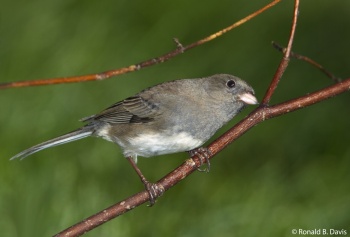(Picture of female. Taxonomy. References) |
(Video link) |
||
| Line 59: | Line 59: | ||
{{ref}} | {{ref}} | ||
==External Links== | ==External Links== | ||
| − | {{GSearch|Junco+hyemalis}} | + | {{GSearch|Junco+hyemalis}} |
| + | <br /> | ||
| + | {{Video|Dark-eyed_Junco}} | ||
| − | [[Category:Birds]] [[Category:Junco]] | + | [[Category:Birds]] [[Category:Junco]] [[Category:Videos]] |
Revision as of 23:42, 14 January 2012
- Junco hyemalis
Includes Guadalupe Junco
Identification
5-6 1/4 in (13-16 cm)
This species shows much geographic variation in color, with many recognized populations or subspecies. All are easily recognizable as Juncos, due to the body shape and behavior. The subspecies are named and grouped variously depending on the authority listing them, but the following four major designations are common:
Oregon Junco
Found in western populations. The male has a black hood, chestnut mantle, and white underparts with buff sides. The female has a gray hood.
Slate-colored Junco
The male has a dark slate-gray head, upper breast, flanks, and upperparts, with a white lower breast and belly.
Both forms have pink bill and dark gray tail with white outer tail feathers conspicuous in flight.
White-winged Junco
Isolated populations in the pine forests of the Black Hills in western South Dakota and eastern Montana. Two white wing bars, extensive white in outer tail feathers.
Gray-headed Junco
Populations in the Southwest. Gray overall, with reddish-brown back.
Distribution
Northern birds migrate further south; many populations are permanent residents or altitudinal migrants. In winter, juncos are familiar in and around towns. The "Slate-coloured" Junco is a rare vagrant to western Europe and has wintered in Great Britain, usually in a domestic garden.
Taxonomy
The best-known species of junco, a genus of small American sparrows.
Until recently the many geographical forms of this bird were considered separate species, but since they interbreed wherever their ranges meet, they are now considered one species.
Subspecies
There are around 15 subspecies[1]
Slate-colored Group
- J. h. hyemalis: Northern Alaska and Yukon to north-central US; winters to northern Mexico
- J. h. carolinensis: Appalachian Mountains to northern Georgia
- J. h. cismontanus (Cassiar): South-central Yukon to west-central Alberta; winters to northern Baja and central Texas
Oregon Group
- J. h. oreganus: Coastal south-eastern Alaska to central British Columbia; winters to central California
- J. h. montanus: Interior British Columbia and south-western Alberta to eastern Oregon, western Montana, central Idaho
- J. h. shufeldti: Western slopes of coastal mountains from south-western British Columbia to western Oregon
- J. h. thurberi: Southern Oregon to mountains of San Diego Co. and southern Nevada; winters to northern Baja, south-western New Mexico
- J. h. pinosus: Coastal ranges of California (San Francisco to southern Monterey Co.)
- J. h. pontilus: Mountains of northern Baja California (Sierra Ju rez)
- J. h. townsendi: Mountains of northern Baja California (San Pedro M rtir)
- J. h. mearnsi (Pink-sided): South-eastern Alberta, south-western Saskatchewan to eastern Idaho, Montana, north-eastern Wyoming
- J. h. aikeni (White-winged): South-eastern Montana to western South Dakota, north-eastern Wyoming and north-western Nebraska
- J. h. caniceps (Gray-headed): Mountains of southern Idaho to Utah and northern New Mexico; winters to north-western Mexico
- J. h. dorsalis (Red-backed): Mountains of New Mexico, northern Arizona and extreme western Texas
- J. h. insularis (Guadalupe): Oak-pine forests of Guadalupe Island (off west Baja California)
Habitat
Openings and edges of coniferous and mixed woods; in winter, fields, roadsides, parks, suburban gardens.
Behaviour
This lively territorial bird is a ground dweller and feeds on seeds and small fruits in the open. It also moves through the lower branches of trees and seeks shelter in the tangle of shrubs.
Breeding
The 3-6 pale bluish or greenish eggs, with variegated blotches concentrated at the larger end, are laid in a deep, compact nest of rootlets, shreds of bark, twigs, and mosses, lined with grasses and hair, placed on or near the ground, protected by a rock ledge, a mud bank, tufts of weeds, or a fallen log. Incubation lasts about 12 days by the female only. Young juncos leave the nest from 10 to 13 days after hatching. These birds often have 2 to 3 broods a summer.
Diet
Insects, seeds, and berries.
Vocalisation
Song: A high trill
Call: A rapid tew tew tew. Sometimes given softly
Also, tzeep tzeep especially when disturbed
References
- Clements, JF. 2011. The Clements Checklist of Birds of the World. 6th ed., with updates to August 2011. Ithaca: Cornell Univ. Press. ISBN 978-0801445019. Spreadsheet available at http://www.birds.cornell.edu/clementschecklist/downloadable-clements-checklist
Recommended Citation
- BirdForum Opus contributors. (2024) Dark-eyed Junco. In: BirdForum, the forum for wild birds and birding. Retrieved 19 April 2024 from https://www.birdforum.net/opus/Dark-eyed_Junco
External Links







